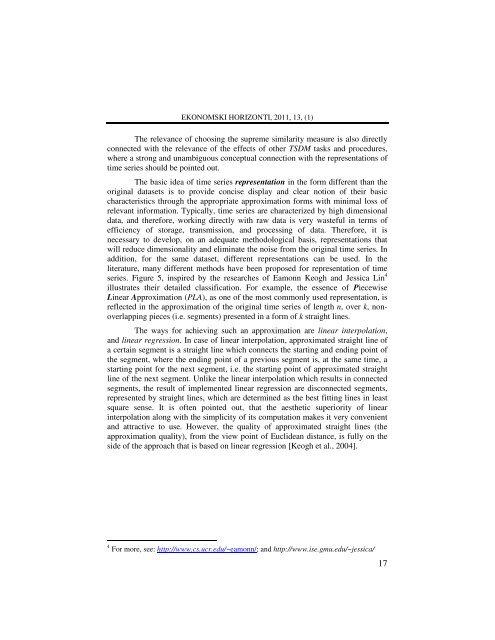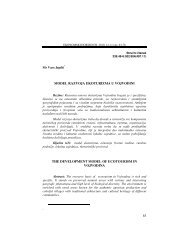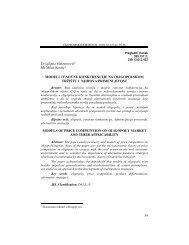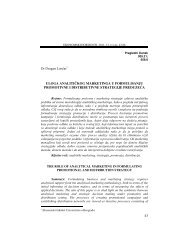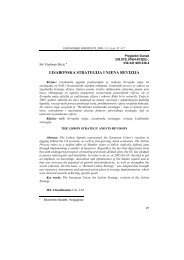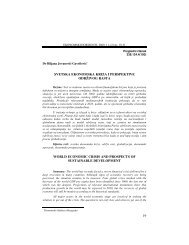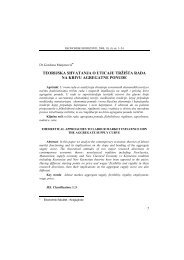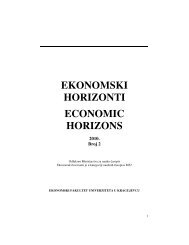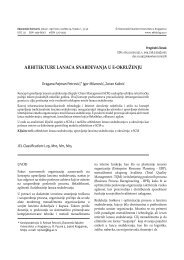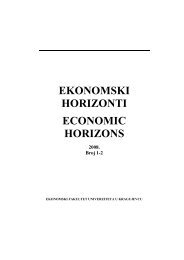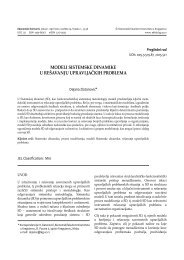yu issn 1450-863 x godina xiii broj 1 / 2011. - horizonti.ekfak.kg.ac.rs
yu issn 1450-863 x godina xiii broj 1 / 2011. - horizonti.ekfak.kg.ac.rs
yu issn 1450-863 x godina xiii broj 1 / 2011. - horizonti.ekfak.kg.ac.rs
Create successful ePaper yourself
Turn your PDF publications into a flip-book with our unique Google optimized e-Paper software.
EKONOMSKI HORIZONTI, 2011, 13, (1)<br />
The relevance of choosing the supreme similarity measure is also directly<br />
connected with the relevance of the effects of other TSDM tasks and procedures,<br />
where a strong and unambiguous conceptual connection with the representations of<br />
time series should be pointed out.<br />
The basic idea of time series representation in the form different than the<br />
original datasets is to provide concise display and clear notion of their basic<br />
char<strong>ac</strong>teristics through the appropriate approximation forms with minimal loss of<br />
relevant information. Typically, time series are char<strong>ac</strong>terized by high dimensional<br />
data, and therefore, working directly with raw data is very wasteful in terms of<br />
efficiency of storage, transmission, and processing of data. Therefore, it is<br />
necessary to develop, on an adequate methodological basis, representations that<br />
will reduce dimensionality and eliminate the noise from the original time series. In<br />
addition, for the same dataset, different representations can be used. In the<br />
literature, many different methods have been proposed for representation of time<br />
series. Figure 5, inspired by the researches of Eamonn Keogh and Jessica Lin 4<br />
illustrates their detailed classification. For example, the essence of Piecewise<br />
Linear Approximation (PLA), as one of the most commonly used representation, is<br />
reflected in the approximation of the original time series of length n, over k, nonoverlapping<br />
pieces (i.e. segments) presented in a form of k straight lines.<br />
The ways for <strong>ac</strong>hieving such an approximation are linear interpolation,<br />
and linear regression. In case of linear interpolation, approximated straight line of<br />
a certain segment is a straight line which connects the starting and ending point of<br />
the segment, where the ending point of a previous segment is, at the same time, a<br />
starting point for the next segment, i.e. the starting point of approximated straight<br />
line of the next segment. Unlike the linear interpolation which results in connected<br />
segments, the result of implemented linear regression are disconnected segments,<br />
represented by straight lines, which are determined as the best fitting lines in least<br />
square sense. It is often pointed out, that the aesthetic superiority of linear<br />
interpolation along with the simplicity of its computation makes it very convenient<br />
and attr<strong>ac</strong>tive to use. However, the quality of approximated straight lines (the<br />
approximation quality), from the view point of Euclidean distance, is fully on the<br />
side of the appro<strong>ac</strong>h that is based on linear regression [Keogh et al., 2004].<br />
4 For more, see: http://www.cs.ucr.edu/~eamonn/; and http://www.ise.gmu.edu/~jessica/<br />
17


